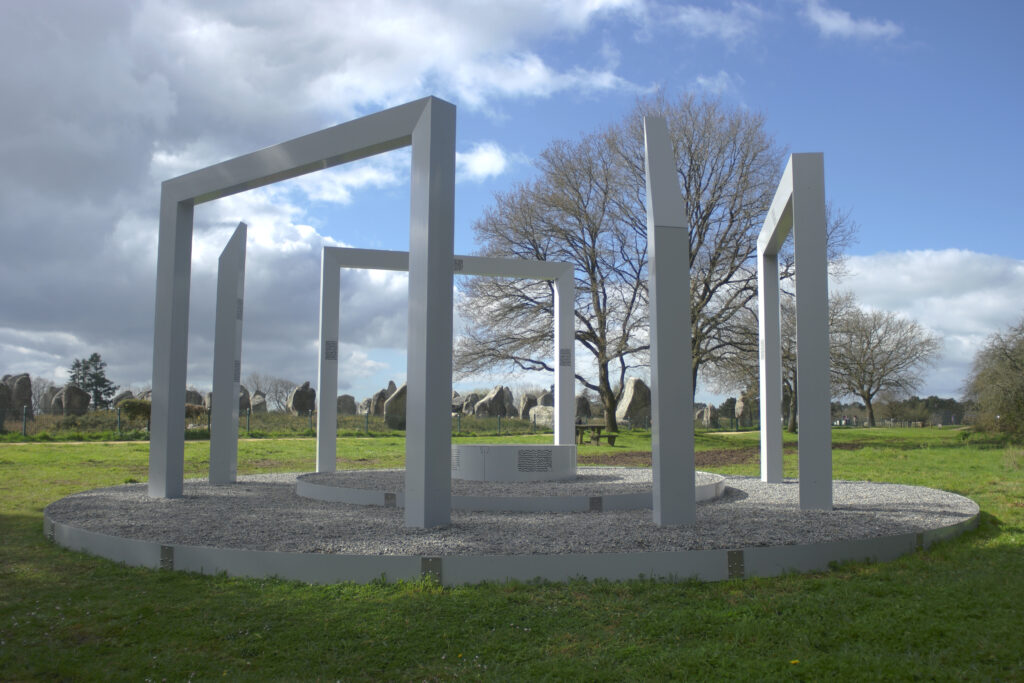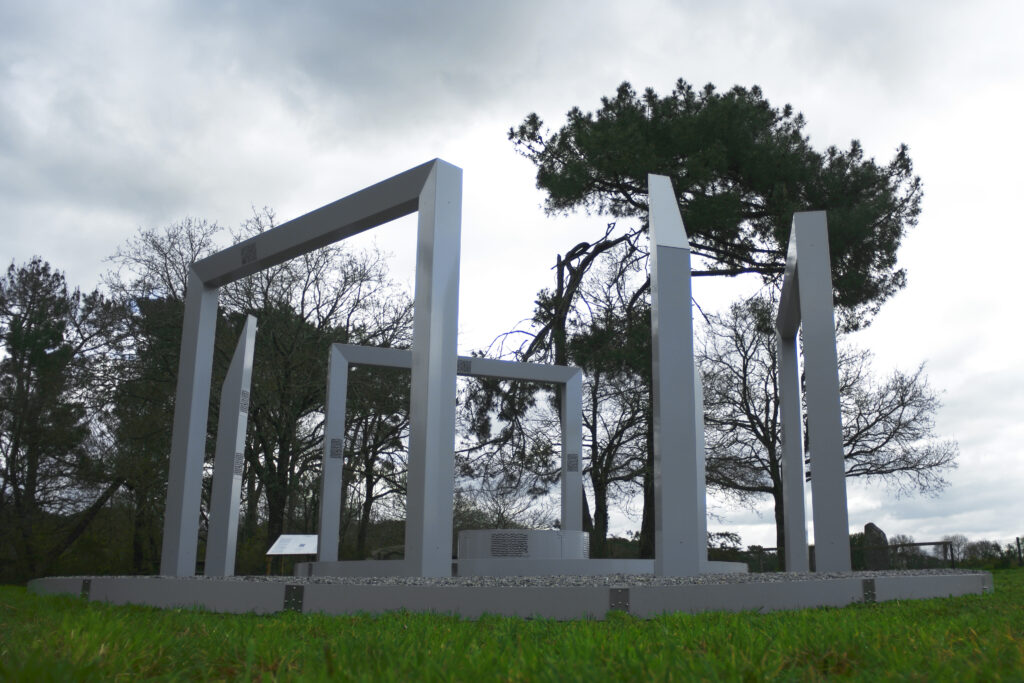
L’infini(e) limite est une installation interactive et générative lauréate du dispositif Mondes Nouveaux (Ministère de la Culture). Elle convoque le sonore et la matière pour exprimer la nature multidimensionnelle des frontières séparant les mondes, qu’ils soient réels ou fictifs, présents ou engloutis, perceptibles ou insaisissables.
L’œuvre monumentale, composée de sept metaloniths (mégalithes en métal) entourant un plateau circulaire en granite d’anatexie accessible par trois marches, s’inspire de la géométrie sacrée des sites mégalithiques de la préhistoire. Elle a été conçue pour s’intégrer harmonieusement aux alignements de Carnac situés dans le Morbihan dont on sait aujourd’hui par les récents travaux publiés par la chercheuse suisse Bettina Schulz Paulsson qu’ils sont les plus anciens d’Europe. De fait, elle a été en mesure de démontrer que non seulement les menhirs de Carnac ont servi de modèle initial à la création des nombreux sites mégalithiques du Vieux Continent, mais aussi que cette diffusion fut extrêmement rapide grâce aux talents de navigateurs jusqu’alors insoupçonnés chez nos ancêtres du Néolithique.
Ainsi, L’infini(e) limite entend-elle rendre hommage aux tout premiers créateurs de mégalithes de Carnac ainsi qu’aux valeureux marins qui exportèrent cette culture architecturale et rituélique de l’Écosse à la Sicile en passant par l’Espagne actuelle.

Le metalonith situé au centre des cercles symbolise l’origine du mouvement. Les cercles concentriques, quant à eux, représentent la diffusion tous azimuts de la culture mégalithique à l’image d’une onde se déplaçant à la surface de l’eau, du centre vers les extrémités, évoquant ainsi la navigation comme principal véhicule de cette transmission. Enfin, le cercle extérieur est constitué d’une série de deux triangles traduisant la matérialisation de l’idée principielle. Le premier triangle est délimité par trois metaloniths-menhirs tandis que le second l’est par trois metaloniths-dolmens.
Cette disposition évoque l’un des plus célèbres sites mégalithiques érigés environ 2000 ans après Carnac : Stonehenge (Angleterre). Au-delà de la figuration d’un geste de révérence du jeune à l’attention de son aîné, le choix de Stonehenge a été motivé par une autre caractéristique elle aussi découverte très récemment concernant les sites mégalithiques, à savoir leurs exceptionnelles facultés acoustiques. Les chercheurs Trevor Cox et Bruno Fazenda de l’université britannique de Salford ont ainsi pu établir en 2012 que la conception de Stonehenge avait pour effet d’amplifier les voix humaines et la musique à l’intérieur de l’ouvrage tout en les rendant quasiment inaudibles de l’extérieur. Alors que la musique s’écoute toujours aujourd’hui dans des temples profanes ou sacrés, il est particulièrement émouvant d’imaginer que cette pratique est à ce point millénaire. L’infini(e) limite réintroduit donc à Carnac cette dimension du sonore, probablement présente dès l’origine de son édification. Bien qu’il n’existe aucune trace de la musique du Néolithique, quelques spécimens ou vestiges d’instruments de musique datant de cette époque ont permis de tenter de l’imaginer et d’inspirer la composition musicale de cette pièce.
Concernant cet aspect sonore et musical, L’infini(e) limite est une œuvre générative et interactive associée à un système de diffusion audio 3D ; elle est un méta-instrument. A l’instar de l’acoustique originale de Stonehenge, le visiteur placé à l’intérieur de l’installation bénéficie d’une expérience sonore immersive totale et saisissante. L’interactivité et la générativité de l’œuvre sont assurées par un dispositif original qui permet de capter l’environnement sonore immédiat du lieu et d’utiliser les sources qui le composent (vent, oiseaux, humains…) pour les intégrer dans l’exécution de l’œuvre après avoir été transformées en stimulus – un tremolo de lithophone distinctif (vibraphone en pierre) indique les moments où l’interaction s’active.
Ces multiples stimuli participent à l’écriture d’une partition interprétée en temps réel par différents instruments numériques virtuels préalablement créés à partir d’instruments de musique du Néolithique : flûtes et appeaux en os (répliques d’instruments appartenant aux collections muséales), flûtes en roseau, appeaux en bois, percussions ainsi que les lithophones issus des collections de préhistoire inestimables du Musée de l’Homme. Ainsi, l’environnement sonore d’aujourd’hui fait-il résonner celui du passé pour offrir aux visiteurs-interacteurs une symphonie aux temporalités multiples. En outre, l’installation simule aléatoirement et sporadiquement deux comportements rudimentaires permettant d’appliquer un effet ludique sur la perception auditive de la scène sonore. Il s’agit dans le premier cas de l’action consistant à appliquer ses mains sur les oreilles de manière répétée et dans le second cas, de l’exécution d’un mouvement de giration inspiré par la danse des derviches tourneurs.
L’infini(e) limite explore ainsi les thématiques complémentaires de la frontière, de la dualité, de la multiplicité et finalement de l’unité en nous invitant à tenter de percevoir ce qui distingue l’esprit de la matière, l’idée du symbole, le sonore du musical, l’âge de pierre de celui du bronze, le passé du présent, le naturel de l’artificiel et enfin l’intérieur de l’extérieur comme le suggère pertinemment le compositeur Jean-Luc Hervé lorsqu’il évoque Déserts de Varèse en tant qu’œuvre dont l’ambition n’était autre que d’établir une relation entre deux lieux ou états différents.
Crédits
Création, conception & composition : Lamozé
Réalisation en informatique musicale & design sonore : Manuel Poletti
Musiciens : Aude Publes Doyen (voix & tambours batá), Frédéric Couderc (flûtes), Damien Petitjean (lithophones), Lamozé (conque, lithophones, percussions, voix, programmation)
Direction technique & ingénieur du son : Alexandre Chaigne
Assistant son : Owen Lempereur
Diffusion : Matthieu Duchêne
Illustration : Aurélien Roccaserra
Régie générale : Sylvaine Nicolas & Fabien Gougeon
Technicien polyvalent : Cédric Ravier
Production : Music Unit
Fabrication structure : Technilum